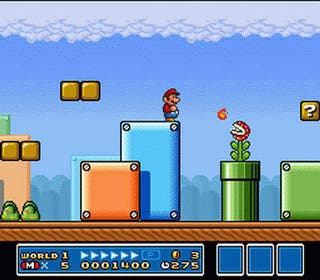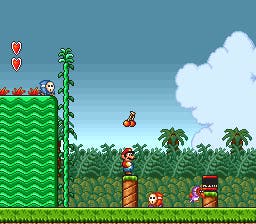Super Mario All-Stars
Crystal castles.
The first game in the set, Super Mario Bros., defined the platform game (or "Athletic Game" as the genre was known internally at Nintendo at the time). It arranged the nascent vocabulary of its genre in the most eloquent and engaging ways. The physics, in particular, are note-perfect; Mario's trajectory when lifting off, his weight in the air, and his speed when settling into a run are all perfectly expressed.
The precision afforded by the controls allows the level design to shine, underground or overground, while the power-ups alter your reach into the world in fascinating yet balanced ways. The game may be venerable, but it's far from outdated. Its genius is in its assured simplicity.
Super Mario Bros. 2 isn't really Super Mario Bros. 2 at all. Rather, it's a re-skinned version of a quirky Nintendo platform game, Yume Kojo: Doki Doki Panic, released in the West under the Mario name because the real sequel was considered too hard for non-Japanese. Despite also being designed by Miyamoto, the result is a Mario game that feels like a cheese-induced dream, its world and inhabitants familiar and yet somehow out of place.

Mario's ground-pound attack is missing, replaced by a system that requires you to pull vegetables from the ground and throw them at his enemies. But while it never quite feels like a true entry to the Mario series, it's nevertheless a strong game on its own terms – and it played a key role in the development of the Mushroom Kingdom by exporting some characters of its own invention back into the series in subsequent titles.
The Lost Levels is the true sequel to Super Mario Bros. In truth, no matter how much the decision not to release it in the West stung, it was probably the right one, though the fault lies with Nintendo. The Lost Levels is brutally unfair, a dark, mean expression of Mario's usual breezy even-handedness.
Poisonous mushrooms, invisible blocks that must be felt out in order to pass some areas, and cruel level layouts stuffed with enemies all bite and sting. Still, the component parts of the experience are strong enough that most will persevere to the end, and for those who missed the game the first time around, The Lost Levels will fill an important gap in your gaming knowledge.
Super Mario Bros. 3 is undeniably the strongest of the set, a beautiful, ambitious, non-linear platform game. Christian Donlan offered an expert critique of it in his thoughtful and personal love letter last month.

Despite only being 951kb in size, the four games nestled together in Super Mario All-Stars represent good value for money. The combined price of downloading each title separately from the Virtual Console (in their original NES versions, mind) is only marginally lower than the £24.99 asking price for this box.
Should Nintendo be criticised for failing to update the code for 2010? Some might say the effort would have outweighed the benefit. These games are supremely playable in their 16-bit form, and while 60hz, non-bordered support would have been welcome, their appeal is undiminished by time and technology's progress.
But perhaps the greatest value of this pack is the packaging itself. Owning a physical copy of Super Mario All-Stars on Wii allows these games to sit proudly on your shelf, a statement to everyone who enters your home and sees it. Here is a game that, in some tiny way, made me the person I am today. Celebrate that with me.
Is a ROM cheaper? Absolutely. Does it offer the same amount of value? Not even close.

